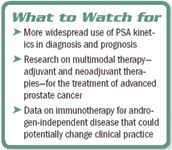Article
New definitions, multimodal therapies will alter practice
The definition of advanced prostate cancer has evolved over thepast decade, and clinical trials now underway are poised totransform clinical practice, according to Paul F. Schellhammer, MD,professor of urology at Eastern Virginia Medical School and programdirector of the Virginia Prostate Center, Norfolk.
The definition of advanced prostate cancer has evolved over the past decade, and clinical trials now underway are poised to transform clinical practice, according to Paul F. Schellhammer, MD, professor of urology at Eastern Virginia Medical School and program director of the Virginia Prostate Center, Norfolk.

The growing importance of biochemical profiles is expected to be a dominant theme at the upcoming AUA annual meeting. On the diagnostic and prognostic side, absolute PSA levels are being complemented by more dynamic measures such as PSA doubling time and annual increments.

"While all of these markers hold promise, they are not yet available for clinical application," Dr. Schellhammer said. "In the future, gene arrays and proteomic profiles may identify specific tumor signatures that are specifically susceptible to one agent or another. Therapies are given now on a 'we'll see if and how it works and hope there is measurable response to evaluate' basis. The potential to specifically target therapy is the desired goal, but validated algorithms to do so are still a bit into the future."
Combination therapies
In the area of treatment for advanced disease, multimodal therapy is emerging as the next frontier as researchers add neoadjuvant and adjuvant therapies to traditional protocols.

Urologists can also look forward to results from a pair of phase III immunotherapy trials employing sipuleucel-T (Provenge) and GVAX for the treatment of hormone-refractory disease. One sipuleucel-T trial has been completed, and results are being confirmed in a second trial.
"If there is a favorable assessment of either of these immunotherapy trials, they would clearly affect clinical practice for patients with hormone-independent metastatic disease," he said.
Expect growing attention to other novel agents, including thalidomide (Thalomid), atrasentan (Xinlay), bevacizumab (Avastin), bortezomib (Velcade), imatinib (Gleevec), EGF receptor inhibitors, mTOR inhibitors, antisense Bcl2, and high-dose vitamin D as single agents or, more likely, in combination with chemotherapy.




